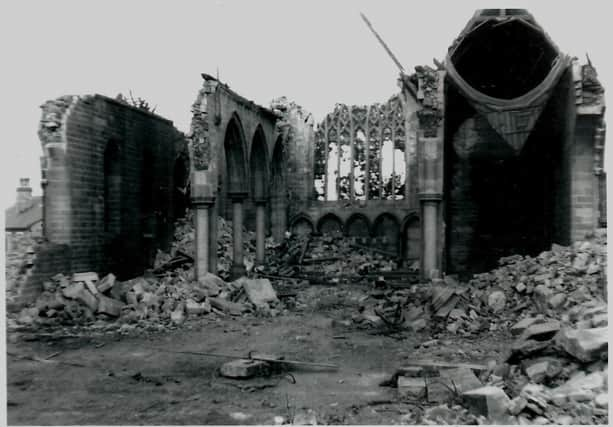Nostalgia with Margaret Watson: Sad closure of our Dewsbury churches


Margaret Watson writes: Many villages in Dewsbury no longer have a Christian presence and I know of at least one Dewsbury church which could close without financial help.
So common are church closures these days that sometimes they close with little or no comment.
Advertisement
Hide AdAdvertisement
Hide AdNo doubt the biggest cultural change our town has seen in recent years has been the wholesale closure of churches.
If people no longer want to go to church there is little we can do about it, but I do wish local people would at least fight to ensure the buildings remain for other uses.
After all, these were the churches which our forefathers once struggled to build and put their hearts and souls and hard-earned money into maintaining them.
Some were built over 200 years ago and became an important part of our heritage and also part of our landscape.
Advertisement
Hide AdAdvertisement
Hide AdTheir steeples and spires, like our mill chimneys, could be seen for miles around and they gave our town a special identity.
Our mill chimneys are long gone, but how sad it would be if all our church spires and church towers also disappeared.
At least three church steeples have disappeared in Dewsbury in my time – St Philip’s, Eastborough, St John the Baptist, Westtown, and St Peter’s, Earlsheaton.
I remember St John the Baptist’s being demolished during the slum clearance of Westtown in the 1960s.
Advertisement
Hide AdAdvertisement
Hide AdAll around me areas like Westtown and The Flatts, Springfield and Batley Carr, were being flattened as part of a major slum clearance programme.
Little chapels and churches which had been places of worship for many years were being razed to the ground, along with pubs and clubs, shops and thousands of houses.
Promises were made that St John the Baptist would be rebuilt elsewhere, but It wasn’t.
Church spires are so typical of the English landscape that you know you are in England when you see them rising into the sky.
Advertisement
Hide AdAdvertisement
Hide AdWhenever I look at a church spire, I literally hold my breath in wonderment, and say a prayer of thanksgiving for the people who built it.
They remind me of the days when there was a great well of spirituality in Dewsbury which people drew upon, especially in times of need.
How many mill workers in the past have looked up from their looms and out of the factory window to see majestic church spires nearby, and for a brief moment the cares of the day would have been wiped away?
These spires once spoke to the soul and gave local people a great sense of peace, security and belonging, making them proud to belong to a town with so much beauty and history.
Advertisement
Hide AdAdvertisement
Hide AdOver the years I have chosen to go to different churches on Sunday morning in an attempt to support them all and to see how they are faring.
I have been greatly saddened to see how many of them are struggling, and I wonder if it isn’t time for us all, no matter what denomination, to come together for the sake of Christian unity.
From being a child, despite being a Catholic, I have always been attracted to churches of different faiths.
I was three-years-old when I entered my first “protestant” chapel – Ebenezer Congregational Church – now the United Reformed and Methodist Church on Longcauseway.
Advertisement
Hide AdAdvertisement
Hide AdI attended a Christmas party for poor children, which the church put on every Christmas morning, and I have loved that church ever since.
I am relieved and pleased to see it is still there and flourishing, and no matter what happens in the future, the building will always remain because it is listed.
When I was six, I went to a Harvest Festival in Springfield Congregational Church (now demolished), something which my church never had.
Later I was to go with my sisters to Sunday school services at a Quaker Meeting House in Bradford Road where we were welcomed with open arms.
Advertisement
Hide AdAdvertisement
Hide AdWhen I was 14, I went to my first beetle drive at Granville Street Methodist Chapel near my home on the Flatts – also now long gone.
I also went to Centenary Methodist Church with my non-Catholic friends, and at the age of 17, attended a service in Leeds Road Baptist Church which, thankfully, is still with us today.
During my journalistic career I have covered just about every church event under the sun and learned much about how all these different churches practice their faith.
Indeed, attending different churches has taught me more about the bread and butter of Christianity than I could ever have learned from my Catholic catechism which I learned by rote every morning at school.
Advertisement
Hide AdAdvertisement
Hide AdSadly, Catholic churches are now suffering the same dwindling attendances and financial difficulties as their Methodist and Anglican counterparts.
The shortage of priests has meant that many Catholic churches in this district have had to merge. Some have even closed.
The Church of England is also suffering from a shortage of priests with some churches having to rely on retired clergy to help out with Sunday services, funerals, christenings and weddings.
Church closures also mean the demise of the organisations connected with them, like Mothers’ Union, Scouts and Cubs, Girl Guides and Brownies.
Their buildings are also used, particularly in villages, as community centres.
When a church closes, a way of life also goes with it.